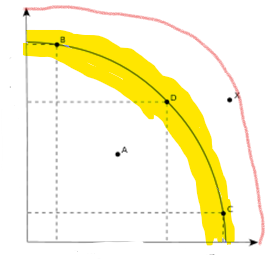In economics, the production possibility curve (PPC) reflects scarcity, choice and opportunity cost. Suppose there are two goods produced, the curve shows the combination of the two goods that can be produced when the resources are fully employed. The curve isn’t static - technological improvements can shift the curve outwards. A point below or on the curve represents the current state of production. A point outside of the curve indicates an impossible production state.

I think that this mental model can also be applied to our personal lives.
We all have a finite time on Earth (scarcity), every decision we make has an opportunity cost to it. We can imagine that the PPC indicates a theoretical boundary of maximum utility, and opportunity costs are realized as moving along the curve (assuming maximum utility).
Some decisions can move the curve outwards or inwards. Getting a good education moves the curve outwards for example. Every “suboptimal” decision we make is a slip away from that theoretical optimum.
Associated with any given time is the current state represented by a point and a “potential” PPC curve. If we consider all possible curves across all possible time lines in our finite lifespan then we can define a notion of possible PPCs (the highlighted region below), and can plot how it can change in a given time frame. Similar to how analysts try to predict inflation rate and giving a probabilistic range.

When debating about nature vs nurture, one can think of a maximal PPC endowed at birth (represented by the red line) which is dependent on familial background, genes, etc. Every decision made in life either keeps this curve as is, or moves it inwards due to a sub optimal decision. Sometimes, we make so many suboptimal decisions that certain state (D) becomes no longer within reach.